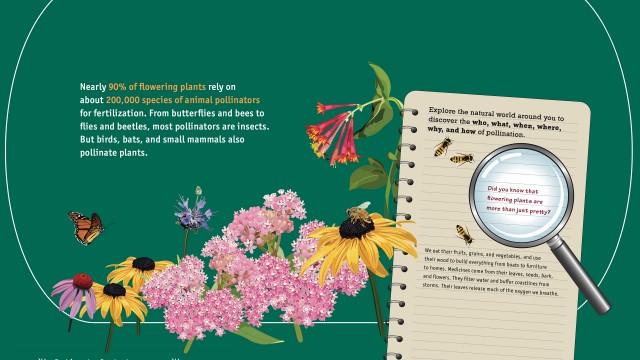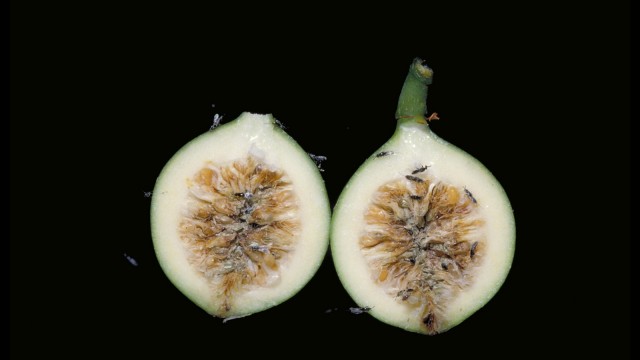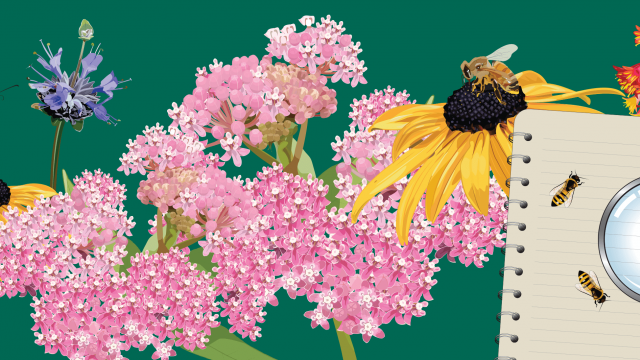
Pollination Investigation: Field Journal
In this activity students will learn to identify a range of common pollinators and plants through their own scientific observations. Through research and observation, students will develop critical thinking and creative problem-solving skills by identifying pollinators and flowers and creating unique solutions for supporting pollinators.
This learning activity is designed to be used in conjunction with the Smithsonian Gardens Pollination Investigation Pollinator Posters. Standards of Learning are listed at the end of activity instructions.
Download the instructions below as a pdf.
Download field journal (English).
Download field journal (Spanish).
Key Terms
- Anther: The male part of a flower, where the pollen is produced.
- Avian: relating to birds
- Crateriform: A wide, shallow, bowl-like flower
- Cyanthiform: Similar to crateriform. This flower shape is wide and cup or bowl-like, but not as shallow.
- Funnelform: Similar to the tubular flower shape. This flower shape is wider, but still conical.
- Invasive Species: A plant or animal that is transplanted to an area that it is not native to, may not have its normal competitors, and may be able to grow in a way that can endanger other plant and animal populations in an area and disrupt ecosystems.
- Mess and Soil Pollinator: A term referencing beetles’ tendency to not only eat pollen and nectar in a flower, but also to perform other life functions such as defecation
- Native plant: Native plants are plants that have grown and adapted to a region over time. This process of gradual adaptation helps plants develop features that allow them to live cooperatively with other plants and animals in their environment.
- Nectar Guide: Markings on a flower, sometimes only visible under UV light, that guide pollinators to a flower’s pollen.
- Pollen: A fine, often yellow, powder produced by flowers. It fertilizes other flowers of the same species so that they can produce seeds.
- Pollination: Part of the reproductive cycle of many plants where a pollinator moves pollen from one flower’s anther to another flower’s stigma.
- Pollinator: A pollinator facilitates the act of pollination, helping to move pollen grains.
- Proboscis: A long, tongue-like mouthpiece used by butterflies and moths to drink nectar from flowers.
- Stigma: The female part of a flower, where pollen germinates to later form a seed or fruit.
- Tubular: A long tube-like flower
What You Will Need
Prepare a slideshow with a few plants and pollinators that are native to your area.
Plan a field trip to a greenspace, local garden, or school garden where students can find flowering plants.
If going to a green space in person isn’t an option, bringing cut flowers and pinned insects into the classroom or using pictures of native flowering plants and pollinators can work as well. Make sure each student has a flower and one or more pollinators to investigate with multiple angles to look at.
Students will need the following materials:
- The Pollination Investigation Journal
- A pencil/pen, paper, and clipboard or binder to write on
- Either virtual access to or printed posters of the Smithsonian Gardens’ Pollinator Profiles
- Optional resources: magnifying glass, colored pencils, crayons or watercolors, and phone or tablet to take pictures of flowers and pollinators
Assembling the Pollination Investigation Journal
- Print out the Pollination Investigation Journal (also available in Spanish). Journals can either be stapled together or hole-punched and put into a half-inch binder.
- Make sure each student has a complete copy.
- Allow students to design their own cover page with their name. A binder works best, so that students will have a hard surface to write on while making observations outside. If you are not using a binder, students should have clipboards or something else to make writing easy while outdoors.
Pre-Activity Discussion
- Students should avoid handling the pollinators that they are observing and should not pick any of the flowers that they are learning about. We want to investigate our local environment to get a better understanding of the pollination process. It is our responsibility to keep our environment healthy for others to enjoy and learn about. Flowers play a very important role in this process and we should leave them for our pollinator friends.
- If a pollinator decides to visit a flower while we are journalling about it, it is important to give it plenty of space to do its job. Some pollinators, like bees, might sting if they feel threatened, but are usually perfectly safe and are not interested in us.
- Students should read key words and understand the basic principles of pollination and pollinators before attempting this activity. Resources like the Smithsonian Gardens’ Pollinator Posters and The Why, What, When, Where, Who, How of Pollination can help better their understanding.
Pollination Investigation Activity
- Have each student observe a flower or a pollinator.
- Students should fill out the Pollination Investigation Journal sheet that matches the flower or pollinator that they observe. If students would like to make multiple drawings of a pollinator or observe a pollinator that isn’t represented in the journal already, there are blank journal pages available.
Post-Activity Discussion and Further Study
After students fill their journals with observations, ask them to compare their notes to the pollinator description sheets.
- Which pollinator do they think they would be most likely to find on the flowers that they observed? Why?
- Which flowers do they think would attract each kind of pollinator? Why?
- Have students compare the pollinator and flower features to the native plants and pollinators that you discussed before the activity. Do they recognize them? Are they a native to your area?
- Why do students think it would be important to have native plants and pollinators in their garden? How do invasive species affect our ecosystems?
For an extended project students can come up with a Garden Design Plan as an essay and/or art project.
- What native plants could they plant in their gardens to help create safe habitats for pollinators?
- What would they plant each season? Just like us, many pollinators need to have access to food every season of the year. We can help them by planting diverse gardens that bloom in multiple seasons. At Smithsonian Gardens, horticulturists plant Helleborus spp. (Hellebore, Lenten Rose, Christmas Rose) that bloom even in the snow!
- Which pollinators would be attracted to their plants?
- Where would these pollinators take shelter or find clean water in their gardens?
For an art class students can draw plans for their gardens each season.
Share your garden plans with Smithsonian Gardens at gardens@si.edu or on Facebook and Instagram @SmithsonianGardens or on Twitter @SIGardens!
Standards of Learning
NSTA ESL/Literacy standards:
- Finding reputable sources
- Developing argument and reasoning skill
NSTA Standards:
Interdependent Relationships in Ecosystems (K-2)
Interdependent Relationships in Ecosystems (Middle School)
LS2.A Life Science
- 2-LS2-2 Plants rely on animals for pollination or to move their seeds around (K-2)
- MS-LS2-2 Native and Invasive Species and their effects on ecosystems (Middle School)
- MS-LS2-5 The importance of biodiversity (Middle School)
ETS1.B Developing Possible Solutions: Post-Activity Garden Design Plan
Growth, Development, and Reproduction of Organisms (Middle School)
LS1.B Growth and Development of Organisms: MS-LS1-4 Plants reproduce in a variety of ways, sometimes depending on animal behavior and specialized features for reproduction.
Human Impacts (Middle School): ESS3.C Earth and Human Activity
MS-ESS3-3 Human activities have significantly altered the biosphere, sometimes damaging or destroying natural habitats and causing the extinction of other species. But changes to Earth’s environments can have different impacts (negative and positive) for different living things.



